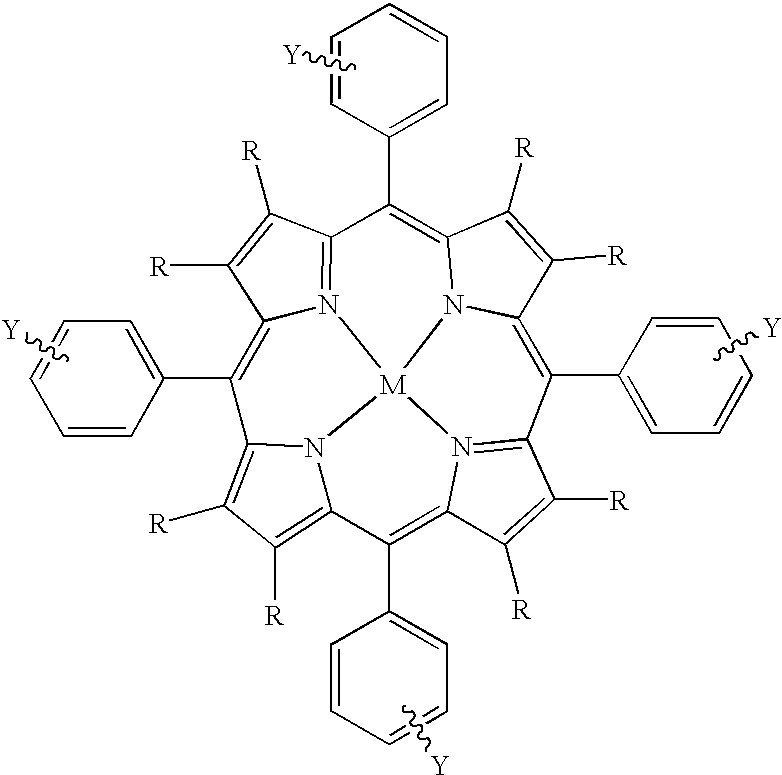Metalloporphyrins and their uses as radiosensitizers for radiation therapy
a radiosensitizer and metaloporphyrin technology, applied in the direction of biocide, drug composition, group 3/13 element organic compounds, etc., can solve the problems of limited clinical applicability, hypoxic cells in tumors, and limited tumor dose,
- Summary
- Abstract
- Description
- Claims
- Application Information
AI Technical Summary
Benefits of technology
Problems solved by technology
Method used
Image
Examples
example 2
Tumors of the Dorsal Thorax
Five BALB / c mice bearing subcutaneously implanted EMT-6 mammary carcinomas on the dorsal thorax were given a total dose of 186 .mu.g CuTCPBr / g body weight in 6 intraperitoneal (ip) injections over a period of 2 days. Four days after the last injection mice were euthanized and the average boron concentrations (.mu.g / g wet tissue) were measured for different types of tissue. The results are shown in Table 1.
No toxic effects were noted either physically or behaviorally in the mice during and after porphyrin administration. At necropsy, all tissues appeared normal.
example 3
Tumors of the Leg
In this example, BALB / c mice bearing subcutaneous EMT-6 leg tumors were given 156 .mu.g CuTCPBr / gbw in a volume of 0.01 mL / gbw / injection over a period of 2 days. Boron concentrations (.mu.g / g) in various tissues from the BALB / c mice was then tested and the results are shown in Table 2.
It is noteworthy that the tumor boron concentrations in the leg are significantly lower than those found in the dorsal thorax. There is a larger vascular system surrounding the dorsal thorax compared with the leg, which may be a factor. However, in the case of CuTCPH, the boron concentration was 30% higher in leg tumors compared to back tumors. Normalizing to the slightly higher dose of the first study, the tumor boron concentration should be about 29 and 15 .mu.g / g at 2d and 5d, respectively, which are still low. Studies are underway to repeat these experiments.
In the tests shown above in Examples 2 and 3, no toxic effects were noted either physically or behaviorally in the mice durin...
examples 5-7
Biodistribution Studies of CuTCPBr
EXAMPLE 5
Two groups of seven (7) BALB / c mice bearing EMT-6 mammary carcinomas on the back were given CuTCPBr at a dose of 432 .mu.g / g body weight (94 .mu.g B / gbw) in six intraperitoneal injections over two days. Two days after the last injection, the mice in one group were euthanized and the boron concentrations in various tissues were measured. Four days after the last injection, the same procedure was carried out on the second group of mice. The average boron concentrations (mean with standard deviation in parentheses) for the two groups of mice injected with CuTCPBr are listed in the second and third columns of Table 4.
The results for CuTCPBr in Table 4 show that the tumor boron concentrations were high and the tumor to blood and tumor to brain boron concentration ratios were also high. The tumor to blood boron concentration ratio after two days was approximately 8:1 and after four days it increased to 232:1. The tumor to brain boron concentratio...
PUM
| Property | Measurement | Unit |
|---|---|---|
| average energy | aaaaa | aaaaa |
| body weight | aaaaa | aaaaa |
| reduction potential | aaaaa | aaaaa |
Abstract
Description
Claims
Application Information
 Login to View More
Login to View More - R&D
- Intellectual Property
- Life Sciences
- Materials
- Tech Scout
- Unparalleled Data Quality
- Higher Quality Content
- 60% Fewer Hallucinations
Browse by: Latest US Patents, China's latest patents, Technical Efficacy Thesaurus, Application Domain, Technology Topic, Popular Technical Reports.
© 2025 PatSnap. All rights reserved.Legal|Privacy policy|Modern Slavery Act Transparency Statement|Sitemap|About US| Contact US: help@patsnap.com



